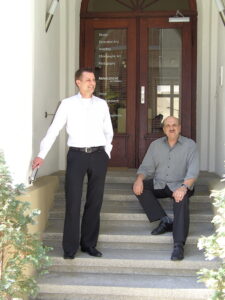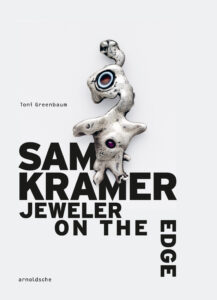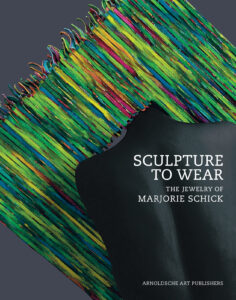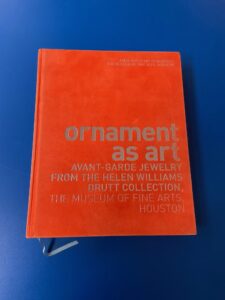Episode 204
What you’ll learn in this episode:
- How Arnoldsche collaborates with authors to create an effective design for each book
- What young artists should know before trying to publish a book
- How Dirk keeps tabs on trends and new developments in jewelry and decorative arts
- How Arnoldsche selects the right markets and languages for its books
- Why the art book market has changed dramatically over the last 10 years, and how Arnoldsche has adapted
About Dirk Allgaier:
Since April 2015, Dirk Allgaier has headed Arnoldsche Art Publishers, an internationally active publisher of art books that offers a unique list of titles in the fields of fine art, applied art and design. With great expertise, sheer hard work and a passion for his profession, he and his team ensure that books from Arnoldsche become what they are: high-quality, individually designed publications and book objects that transport the broad range of creative endeavor in all its diversity across the globe.
Additional Resources:
- Arnoldsche Art Publishing’s Website
- Arnoldsche Art Publisher’s Instgram
- Arnoldsche Art Publisher’s X/Twitter
Photos:
Dieter Zühlsdorff, founder of Arnoldsche Art Publishers, with Dirk Allgaier, (Dirk Standing)


Cover of the publication “Sculpture to Wear. The Jewelry of Marjorie Schick”, published 2007

Cover of the publication “Ornament as Art. Avant-Garde Jewelry from the Helen William Drutt Collection, The Museum of Fine Arts, Houston”, published 2007

Transcript:
No other publishing house in the world has published as many books on jewelry, ceramics and other applied arts as Arnoldsche Art Publishing. Led by Dirk Allgaier, Arnoldsche is the go-to source for anyone who wants to learn more about the decorative and applied arts, the people who create them, and the museums that exhibit them. Dirk joined the Jewelry Journey Podcast to talk about how he selects the 10 to 15 books Arnoldsche publishes each year; how he works with artists to create a beautiful and informative book; and why a language barrier doesn’t always prevent someone from reading an art book. Read the episode transcript here.
Sharon: Hello, everyone. Welcome to the Jewelry Journey Podcast. This is the first part of a two-part episode. Please make sure you subscribe so you can hear part two as soon as it’s released later this week.
My guest is Dirk Allgaier of Arnoldsche Publishing. They’re art publishers, and if you have any kind of design library—and that includes jewelry, ceramics, monographs on artists, furniture and more—you no doubt have books that have been published by Arnoldsche. As I was browsing the books online, I kept seeing so many books I have that I didn’t know were published by Arnoldsche. For the most part, they are in English and German, and the books are beautifully printed. Dirk will tell us how his path took him to where he is today. Dirk, welcome to the program.
Dirk: Thank you very much, Sharon. Very glad to be here.
Sharon: I’m so glad to have you here. Dirk was just telling me that he has lived in Stuttgart for 30 years, 25 years, a long time. Can you tell us what a publisher does?
Dirk: That’s a very good question, Sharon. There’s really a lot to it. I tried to explain to you some things, to tell you about some things. Mainly it is my job to see that we put together an attractive book program every six months, every half-year. This is in the field of applied arts, which is our main series of books. It’s jewelry, ceramics, textiles, wood and glass, but also the areas of visual design, of the visual arts and design.
I receive many book proposals. I have to check them. I have to calculate them, but I’ve also got to be active by myself from my side, and I have to talk to artists. I have to meet museum curators. For example, I go to museums, to exhibition openings. I go to Schmuck in Munich, so I’m really traveling a lot. I visit all these places. You also have to be in the field where our publishing areas are, in the field of jewelry, of ceramics. I have to be there; I have to be active.
In parallel, we have to put out used books. We have 10, 15 books always in parallel production, and we have to approach miniatures. The production is supervised by the project managers, but I’m integrated into the processes of each book because I have to know the exact starters of every book project. I must be approachable by the artist, by the museum curator, by the director if any problem arises or if important decisions have to be made.
So, one part is traveling; the other part is production. I’m also responsible for sales and marketing. We have a colleague who does this, but I also have to look at how things can be optimized, how we can sell the books in the best way internationally. Unfortunately, a lot of administrative tasks have to be done. They are also very extensive. Finally, I write some articles for newspapers, for magazines. I give talks. I hold speeches for exhibition openings. I attend meetings, or I’m speaking for podcasts like now. This is also a very interesting and exciting part of my role as a publisher. All in all, there’s a lot of work, enough work to work for at least seven days a week.
Sharon: Are you saying that right this minute, there are 10 to 15 books that are being worked on?
Dirk: Yes, that’s it. About 10 to 15 books are always in production parallel, in the different steps of production. Either we are actually starting the editing, or we are preparing the design, or we are doing translations, or we are doing the color separations. Today, the Schmuckmuseum of Pforzheim curator was here. We’re doing a new book about jewelry and metalwork, and we checked the colors. We checked the color proofs today. We discussed the cover. There are always a lot of book productions in parallel here at Arnoldsche.
Sharon: This is something that is just occurring to me. Do they have input? If they don’t like the color, can they say to you they don’t like the color?
Dirk: That’s very important. I try to show everything to my partner, to the museum or to the artist. I show them the design concept of the book so we are not only designing the book. Before we start with the real design, we make some tests on pages, and we send the pages to the artist or to the museum. We say, “Oh, look, the book could look like these pages. Here is a type that’s the kind of like the images. The captions are like that. We have some special colors.” Then the museum can say, “Oh, I like it. Please continue,” or “Oh no, I want to have a different kind.” This is very important for me in the production, to work as closely as possible together with the museum or the author.
Sharon: Can the museum come and say, “I had something totally different in mind”? Can whoever is working on the book say they had something else in mind?
Dirk: Yes, they can say it. Usually, we get a briefing and the museum tells me, “Oh, I want a very modern book,” or “Very conservative,” or “I have some crazy ideas.” But it must fit to the topics; that’s very important. We publish books about 18th century arts and crafts, about porcelain from the 18th and 19th centuries. Here’s a design that has to be quite conventional, or conservative is a better word. But if we work with a very unusual, contemporary designer, we can be much more provocative and contemporary in the design.
Sharon: How did you come to publishing art and applied design books? Do you have a background in it?
Dirk: Yes, I’ll tell you shortly the story of the company. Arnoldsche, our publishing house, was founded in 1985. This is now almost 40 years ago. The founder of the publishing house—he passed away five years ago—his name was Dieter Zühlsdorff. He had previously, back in the 1970s, lived here in Stuttgart. He had a gallery for fine arts, for paintings, but his real passion was not the fine arts; it was ceramics. In the late 70s, early 80s, he closed the gallery and wrote an encyclopedia of ceramic marks. He traveled throughout Europe. There was no email, no websites. Maybe a fax machine was the most modern technical thing. He traveled for five years and wrote the “Ceramic Marks Encyclopedia” on the Art Nouveau and Art Deco period from 1880 to 1930.
When the manuscript was finished, he went in search of a publisher. He didn’t plan to found a publishing house, but no publisher wanted to publish his “Ceramic Marks Encyclopedia,” so he was not sure what to do. He sold a painting from his collection to a large bank in Germany. He used this money to print his “Ceramic Marks Encyclopedia,” and that was the beginning of Arnoldsche Art Publishers. That encyclopedia became a best seller in a total of four editions.
The name Arnoldsche comes from his wife at the time. She’s living. Her name is Gabriela Arnold; Arnold is her last name. Arnoldsche is still a little bit complicated for English speakers. Here, Arnoldsche sounds much better in German than Zühlsdorff, which was the last name of the founder. That’s a Pomeranian name, very complicated. I think the English people would not be able to pronounce that name. So, we decided on Arnoldsche, and in German, we say Verlaganstadt. Verlaganstadt means publishing house. That sounds a little bit old-fashioned, but I like that old-fashioned name. In English we say Arnoldsche Art Publishers.
Dieter Zühlsdorff, he acted very wisely when he founded the company because he realized there were many publishers in the area of fine arts or architecture, but there was no publishing house that explicitly dealt with the applied arts, with jewelry, ceramics, glass and furniture. So, we can say internationally, Arnoldsche is the only publishing house in the world that focuses on jewelry, ceramics, glass and textile, and we realized a lot of publications in that field.
Sharon: Did you have a background in it?
Dirk: I’m a trained archaeologist. I’m not an art historian. I studied archaeology. I made my degree. I like it very much, but artistry has fascinated me from a very young age. When I was a child, I went with my parents to see museums, to meet artists. My parents had a collection of paintings.
When I completed my studies, I did a separate training course to become a publishing house clerk. This training course lasted one year. It included a three-month internship in a publishing house, and you had to take care of this internship by yourself. I had no idea where to apply. I was in Stuttgart, and I had a friend who was a bookseller. She gave me a recommendation. She told me, “Apply to a small art publishing house here in Stuttgart. They make the most beautiful books, and they are just around the corner from the place where you have the training.” She was speaking about Arnoldsche.
So, I went there about 30 years ago, in 1993, and I got the job for a three-month internship at Arnoldsche. It started for three months, and now I’m working for 30 years at Arnoldsche. I’m very grateful to my friend for her recommendation. We still meet regularly even though she now lives in northern Germany. I’m very thankful to her for recommending me. “Go to Arnoldsche, ring the bell and apply for a job.” I did that 30 years ago.
Sharon: Wow! Like you said, you must be approached all the time by people who have ideas and say, “Why don’t you do a book on this?” or “I have all this material on that.” How do you decide which books to do?
Dirk: That’s always a difficult decision because we receive a lot of proposals for book productions. For one thing—and I think that’s very important—the book has to fit in our program. For example, a book about the photography of the Alps or about Renaissance art would not fit well in our program. For us, it’s very important to find new topics; in other words, topics that have not been published before. It makes no sense for us to publish a 50s book about Picasso or about Matisse; that’s not our interest.
There has to be a market for a book. It has to be saleable. We have to publish books about artists who have worked for many decades in their fields. Also, younger artists come to me. They’re in their late 30s or their 40s, and they ask for a book. I often say, “Wait another 10 years. You need a bigger work of art, a mature work, and then you can come back to me and we can think about a book.”
Very important art books on the theme of jewelry are the books about the great masters of jewelry. These are really important publications. Just to name a few, for example, Otto Künzli, the Swiss artist, Bernhard Schobinger, Manfred Bischoff. Last year, we published a book about Joyce Scott, the American artist, and the Israeli artist Deganit Stern Schocken, Therese Hilbert. Here, a large body of work over many decades can be wonderfully presented in a beautiful book form. That’s really exciting.
There are publications on collections of contemporary jewelry. This is also very important. These are mainly museum collections. For example, we have published about the jewelry collection of Eva and Peter Herion in Munich, which you can see when you go down to the basement. It’s a major publication about the collection of the jewelry museum in Pforzheim, the Schmuckmuseum. We did it in 1998 with the legendary former director, Fritz Falk. There’s the GRASSI Museum in Leipzig, a very important museum in East Germany. There’s a very traditional collection and there’s a collection of jewelry. They started to collect in the 1920s. We did a book about the jewelry collection of Sylvia Seal and of Art and Design in New York also. These collections are very exciting for us. I do not want to forget to mention the legendary publication by Helen Drutt, “Ornament as Art.” It’s about her collection, which is now in the Museum of Fine Arts in Houston. People call that book the “orange book” or the “Bible of jewelry books.” I think you know that book.
What’s also very important for us are theory books about jewelry. We have a book on the jewelry of Marjan Unger from the Netherlands. She did the book “Jewelry in Context.” These books are very important for students, for example. They are quite affordable in price. They’re 15 Euros, so students buy these theory books.
If you come to Arnoldsche, there’s finally one topic that is very important because it’s the most elementary, because every book can’t be one: special books. We are publishing in a niche; it’s a real niche, and the quantity of books, the editions, are not so high. Every book needs special financial support, so we ask for financial support from foundations. The potential sales is low compared to the very high cost of distribution. You do not usually recoup the high production cost. So, museums, collectors, foundations themselves make books financially possible in the first place through a corresponding purchased quantity. That is how a book can be realized through financial support; by purchasing books in advance. A special part will be paid by Arnoldsche and for the other part, we look for sponsors or our foundations to financially support it. These are the different things to consider for Arnoldsche book publishing.
Sharon: When you are out and about—let’s say you’re traveling—do you find exhibits that you didn’t know about or things you can approach people about?
Dirk: Yes, I go to exhibition openings. Of course, I go to Schmuck in Munich, a big Schmuck event. I go to Munich, to exhibition openings. I go to Norway, to Switzerland, and I always meet the artists. I also meet authors and they tell me, “Oh, I’m working on a project. I’m working with this artist or with that museum. They are looking for a publisher. Would you mind if I make a contact?”
For me, it’s very important to visit these places, to go to openings, to meet curators because we are like a big family. Everybody knows something and people speak with each other. They say, “Here’s a project. There is a book. It’s planned to be an exhibition. They are looking for a publisher. They are planning a book for next year,” and I say, “O.K., please, if you can make a connection and the person can contact me.” Then we are discussing the possibility of collaboration for the book project.
Sharon: Do they come with photographs or do you say, “I want to photograph this”?
Dirk: For me, it’s important to have an exposé, a short summary of the book. What is in the book, what is the sense of the book, whom do I want to reach with the book, who is the audience? And to send me some photographs, some preliminary information to get an idea of how the book will be, what the topic of the book is. That’s enough for me, and then we continue our discussion.
Sharon: Do you or your production assistants decide the cover of the book and what it will look like? Who decides?
Dirk: We have freelance designers. We work together, but often artists or jewelers or ceramic artists who are planning a monograph about their work, they bring their own graphic designers with them. That’s often fine with me because the collaboration between artist and designer is very intensive, and artists and designers should work together personally as often as possible. Often at Arnoldsche, we are responsible for the design, but always in collaboration with the artist.
We have a graphic designer. We’ve worked together with her for almost 13 years. She designs many of our books and many artists know her. They come to us. They say, “We’re planning a book, but we want to have this designer. We trust this designer.” There are artists who give us the whole material. They give us the photographs and the text, then they make a book and she makes a design. We show it before printing and they say, “Oh, make this little change. Oh, make that little change. Go to the press.” There are other artists who look very carefully, who ask for changes, but every one is absolutely fine for us.
We love to work together with her. She designed the book on Helen Drutt for “Ornament as Art,” the orange book, but she also designed important jewelry monographs; for example, the book on Sam Kramer, a jewelry designer. She did the book about Giampaolo Babetto, about Fritz Maierhofer from Austria, about Georg Dobler or Claus Bury, two famous German designers.
Usually, we say if a graphic designer designs the inside pages of a book, they also have to design the cover. The inside pages and cover have to be in accordance with each other. It should fit to each other. That’s very important, to have one designer for the whole book. A designer is also like an artist in a way. You cannot ask an artist to make this part and another artist makes this part. The whole book has to be in the hands of one designer.
Sharon: We will have photos posted on the website. Please head to TheJewelryJourney.com to check them out.

